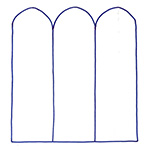Gallery
Competition theme: Telling Tales
A picture's worth a thousand words. That's the reason why artists have used pictures to tell stories for thousands of years.
Schools are invited to explore this theme by visiting MUSA or by using the resources on this page in the classroom. Resources can be used in conjunction with the resource packs available on the Teachers' Notes page, which provide activities and topics for discussion.
Images of the University’s collections
Click on the thumbnails to download large versions of each image in a pdf document.
Pictures that tell stories
Many artworks seek to tell stories. Some seek to tell part of it, some want to tell the whole thing. The story might be well known or have come from the artist's imagination. Look at these artworks and think about the stories they are trying to tell. Which part of the story has the artist chosen? How has he communicated his message? What would you have done differently?
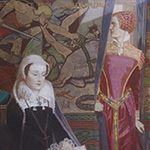 |
1. Mary Queen of Scots at Fotheringhay by John Duncan
This picture shows Mary Queen of Scots shortly before her execution at Fotheringhay Castle. Mary looks composed and is clutching her rosary, probably praying. Look at the expressions of those around her and consider the emotions that they are feeling. The curtain behind Mary shows violent scenes, indicating the violence that occurs next in the story of her life. |
|
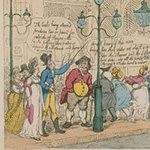 |
2. A Peep at the Gas Lights in Pall Mall by Thomas Rowlandson
Cartoons aren't new! This cartoon comes from 1809. Pall Mall in London was the first place in Britain to get gas lights, a new and efficient way of lighting the streets at night. The cartoon pokes fun at the reactions of the people. The man on the left is explaining how the lights work, while the large gentleman next to him is sceptical. The lady "of ill repute" on the right is concerned about the effect the new lighting will have on her business. |
|
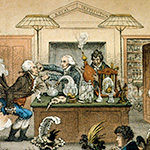 |
3. Scientific Researches! – New Discoveries in PNEUMATICKS by James Gillray
This is another cartoon, this time form 1802. It shows a lecture at the Royal Academy demonstrating the effects of laughing gas. The room is full of caricatures of real, well-known and well-to-do people from the time. Consider how James Gillray has used exaggeration to get his message across. How like the real scene do pupils think the artwork is? |
|
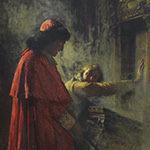 |
4. Cardinal Beaton Besieged by by W.E. Lockhart
This is a Victorian painting of an event that happened 400 years beforehand. It shows Cardinal David Beaton in St Andrews Castle in 1546. He had recently executed a Protestant Reformer called George Wishart. In response, a group of Protestants broke into the castle to kill Beaton. This image shows Beaton barring himself in a room as the Reformers try to gain entry. What do you think the artist wanted to show by colouring Beaton's eyes red? The Reformers succeeded in getting hold of Beaton. They killed him and hung his body from the castle window. |
|
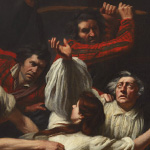 |
5. The Death of Archbishop Sharpe by John Opie
This is another historical painting which John Opie created in 1796. It shows Archbishop James Sharpe being dragged from his carriage at Magus Muir, near Strathkiness. The men who caught him disagreed with the way in which he was trying to change the church – the men were Presbyterians and Sharpe wanted to impose Episcopalianism. They murdered Sharpe. The girl in the picture is Sharpe's daughter. |
|
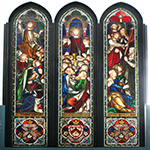 |
6. The Chalmers Window
This window was put into St Salvator's Chapel in the 1860s. It shows three scenes from Jesus' life. On the left is the Sermon on the Mount, in the middle you can see the last supper and on the right Jesus is raising Lazarus from the dead. It was probably intended to give a message that Jesus fulfilled the three anointed roles of prophet, priest and king and so was the Messiah promised in the Old Testament. The window is dedicated to Thomas Chalmers, a former student and professor at St Andrews who went on to start the Free Church of Scotland. |
|
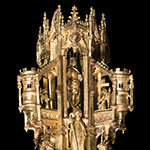 |
7. St Salvator's Mace
This mace was made in 1461 in Paris. It shows Jesus in the centre surrounded by angels. Each angel holds a symbol of the passion – one holds the poll on which Jesus was tied, one holds the cross on which he was crucified and the third holds the spear that pierced his side and confirmed his death. Jesus stands on the world with his hands raised. You can see the nail marks in his hands – this is the resurrected Jesus who is victorious over the world. |
|
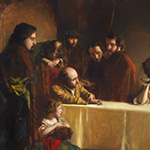 |
8. Wishart's Last Exhortation by William Orchardson
Although the events in this picture happened in 1546, Orchardson painted the picture much later, in 1853. George Wishart was a Protestant Reformer. For this reason the local bishop, Cardinal David Beaton, arrested him. The painting shows Wishart imprisoned in the castle the night before his death. He is giving communion, the first time a Protestant had done this. The following day he was burned at the stake. |
|
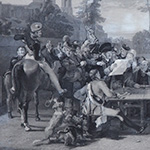 |
9. Chelsea Pensioners Reading the Gazette of the Battle of Waterloo by John Burnett, after David Wilkie
In 1815 the British army beat the French forces of Emperor Napoleon at the Battle of Waterloo. This picture shows retired soldiers, called Chelsea Pensioners, hearing about the news for the first time and celebrating in the streets of London. Take a look at the faces, expressions and gestures of the people. Not everyone is happy – there is a woman on the right who is waiting for news of her husband, who is a soldier in the army. The artwork is an engraved and printed version of a painting by David Wilkie. |
|
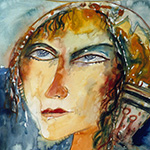 |
10. Woman of the North Sea by John Bellany
This painting shows a woman with a fish on her head. There are various other sea creatures hidden in the painting. What do you think the woman is thinking? How is she feeling? What is the picture intended to show? |
|
Characters
In artworks we can learn a lot about someone by the way they are shown. Their expression can tell us something about how they feel and there are often clues about a person's age, character, job or interests. Why not choose one of these artworks and use the character in a story? What aspects of the character's personality would it be important to show?
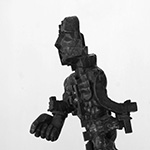 |
11. Standing Figure (Vulcan) by Eduardo Paolozzi
This statue shows the Roman god Vulcan. Vulcan was the god of metalworkers and his body is made to look like tools that a metalworker would use. Eduardo Paolozzi was from Edinburgh. He was a pioneer of the Pop Art movement, which used references to popular culture. |
|
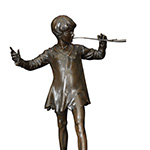 |
12. Peter Pan by George Frampton
Peter Pan was the boy who never grew up, who battled Captain Hook with Wendy and the Lost Boys in Neverland. He was created by the Scottish writer James Barrie. This statue is a smaller copy of one that you can see in London. |
|
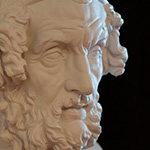 |
13. Homer
Homer was a writer and poet who lived in Ancient Greece. This is a cast, or copy, of a sculpture that is in the British Museum. That sculpture was made by the Romans and was itself a copy of another sculpture, made around 100BC. |
|
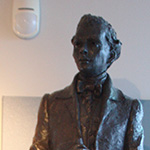 |
14. Robert Fergusson by David Annand
Robert Fergusson was a poet. He wrote in Scots and influenced Robert Burns. He died when he was just 24 years old. This statue is a smaller version of one that you can see in Edinburgh. |
|
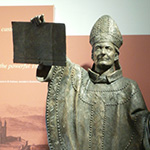 |
15. Bishop Henry Wardlaw by Alan Herriot
Henry Wardlaw was Bishop of St Andrews in the 1400s. He started the University of St Andrews. In this statue you can see him holding his bishop's crozier, or staff, and one of the letters that the pope sent to him allowing him to start the University. The statue was made in 2011. |
|
Template
This template can be used for the stained glass window activity in the P2-P3 Resource Pack.
Please note that all images on this website are copyright of the University of St Andrews and may only be downloaded and printed for teaching purposes.

















